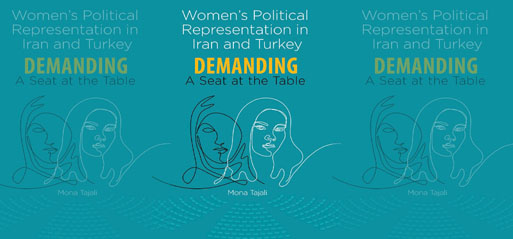
Women’s Political Representation in Iran and Turkey: Demanding a Seat at the Table by Mona Tajali; Page 337; Edinburgh University Press Ltd, 2022; Hardback. $94.
When Benazir Bhutto was elected Prime Minister of Pakistan in 1988 it was an electoral victory that brought a Muslim woman to the highest political office in a Muslim-majority country.
Characteristically the conservative religious establishment denounced her election as against the precepts of Qur’anic injunctions. A convention of over 2,000 religious leaders (Ulamā) declared that a government led by a woman was un-lslamic and urged the people to rise against it. In neighbouring Bangladesh in 1991, Khaleda Zia became the first female Prime Minister of a Muslim-majority country.
After serving till 1996, she regained office from 2001 to 2006. Khaleda was the wife of the former President of Bangladesh, Ziaur Rahman, who was assassinated on May 30, 1981. After his death, she got involved in politics by first becoming a member of the Bangladesh Nationalist Party (BNP) – the party which was founded by Rahman.
Sheikh Hasina, Bangladesh’s second and current woman Prime Minister, was elected to office in 1996. Having served for a combined total of over 18 years, over 4 premierships, as of September 24, 2022, she is the world’s longest-serving female head of a government in history.
Hasina is the daughter of the founding father and first President of Bangladesh, Sheikh Mujibur Rahman, who served as the first President and later as the Prime Minister of Bangladesh until his assassination in 1975.
The thread binding these women is not only the fact they all presided in countries that are largely conservative, patriarchal, and overtly influenced by religious doctrine and ulama with inordinate influence and power.
But that these women faced the personal loss of loved ones is a testament to the fierce determination all of them possess in the face of seemingly overwhelming odds and taking on an establishment that is fiercely opposed to one’s person and principles.
In the case of Bhutto, she paid the ultimate price when she was killed by a suicide bomber while on a campaign trail.
While Muslim women in Muslim-majority countries have made moderate strides in attaining equal rights within the legal framework, the socio-religious-cultural conventions have largely inhibited women from achieving real equilibrium with the larger society.
Since 1988, nine Muslim-majority countries have had women heads of state. Muslim-minority states like Mauritius and Singapore have elected Muslim women as presidents. In 2015, Aeenah Gurib-Fakim became President of Mauritius while in Singapore, Halimah Yacob was sworn in as President in September 2017.
Post the “Arab Spring”, one of the key issues confronting Muslim societies and the Muslim world at large is the position in Islamic discourse of the empowerment of women. Muslim women are asserting themselves and attempting to reclaim the rights that Islam has granted them. It is these rights which Muslim women’s movements and activists claim are part of the Islamic and Prophetic legacy.
The struggle for women’s empowerment, more specifically Muslim women’s empowerment, has become the foundational component that is integrally linked to the political status of Muslim women.
In Women’s Political Representation in Iran and Turkey: Demanding a Seat at the Table, Mona Tajali addresses these fundamental issues and suggests that the recent increases in women’s political representation in Iran and Turkey, and similar trends in several other Muslim countries, can be understood “in terms of the strategic interactions that take place between women’s rights groups and political elites, both of which depend on the support of the electorate.”
Tajali further points out that “women’s groups across the political and ideological spectrum strategically interact with political elites to address women’s political under-representation.
At the same time, political leaders are increasingly sensitive to the power of women’s votes and in an attempt to increase their female support base, increasingly take measures to enable and appoint women to leadership positions. Thus, when opportunities arise within the given structural political context, women’s rights actors and political elites use each other to further their respective interests.”
Iranian-born Tajali has provided a valuable and in-depth analysis of women’s rights groups’ activities and strategies “around female political representation to explain women’s gains in this area despite the significant constraints posed by gender discriminatory ideologies and undemocratic political parties and systems.”
This comparative study of two Muslim-majority countries where conservative gender ideologies dominate explores the “underlying dynamics of these increases in Turkey and Iran, and by extension, suggests an additional lens through which to analyse the status of women’s political rights and roles in the Muslim world.”
“By placing women’s mobilisation and organising for access to positions of political leadership at the centre of its analysis, Tajali demonstrates that “women’s demand for a seat at the political decision-making table transcends religious and ideological affinities. Since at least the mid-1990s, women’s rights groups across the Muslim world, including in Iran and Turkey, have been demanding women’s increased access to political leadership.
Studying women’s organising efforts shows how women manoeuvre within their respective institutional and ideological structures to address women’s political under-representation, and the conditions under which they succeed in convincing ruling elites and the general public to value women’s political inclusion.”
Tajali has provided extensive data through interviews with women, women’s groups, activists and politicians in Turkey and Iran. The experiences of women in these secular and conservative societies gives a glimpse of the identical struggles confronting women in other Muslim-majority countries – Arab Gulf states, Asian sub-continent and North African states.
In this important study of women’s political struggles for representation, Tajali lens should also shift to the efforts of Muslim women to get a seat at the table in countries where they are in the minority.
Religious and scriptural constraints would seem to be of lesser concern in these countries, while the reality of Islamophobia and racism could reveal interesting evidence of external factors inhibiting the real empowerment of Muslim women in truly secular societies.
Mahomed Faizal